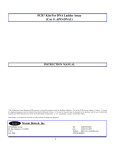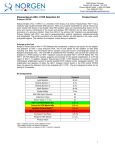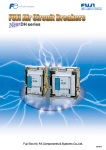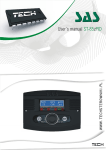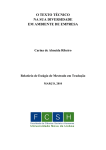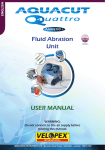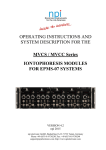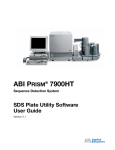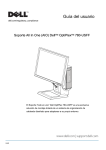Download new HCK-M150G - Maxim Biotech, Inc.
Transcript
780 Dubuque Avenue So. San Francisco, CA 94080, U.S.A. Tel: (800) 989-6296 / Fax:(650)871-2857 http://www.maximbio.com E-mail: [email protected] MPCR Kit for Mouse Chemokine Genes Set-1 Cat No. MP-70068: 50 reactions Cat No. MP-70070: 100 reactions INSTRUCTION MANUAL ID-M10087 Revised August 8, 2002 *These products are designed and sold for use in the Multiplex PCR (MPCR) covered by patent # 5,582,989. Use of the MPCR process requires a license. A limited, non-automated research field license under the patent to use only this amount of the product to practice the MPCR process is conveyed to the purchaser by the purchase of this product. The Polymerase Chain Reaction (PCR) process is covered by patents owned by Hoffman-LaRoche. Use of the PCR process requires a license. A license for diagnostic purposes may be obtained from Roche Molecular System. A license for research may be obtained by the purchase and the use of authorized reagents and DNA thermocyclers from the Perkin-Elmer Corporation or by negotiating a license with Perkin-Elmer. This product is intended for research use only and not for diagnostic purposes. INTRODUCTION Cytokines play important roles in orchestrating and controlling inflammation and sepsis process. The cytokines IL-1, IL-6, and TNF are sometimes referred to as the ‘inflammatory triad’ since they mediate both local and systemic inflammatory responses which are believed to have survival value (1, 2). IL-1 and TNF are rapidly produced by monocytes and macrophages in response to a number of stimuli such as endotoxins, muramyl dipeptides, lectins, immune complexes and other noxious agents. Of these bacteria, endotoxin has frequently been used both in vivo and in vitro to stimulate the production of IL-1 and TNF and to study their activity. IL-6 is produced by a wide variety of lymphoid and non-lymphoid cells both constitutively and in response to many stimuli including other cytokines. For example, both IL-1 and TNF are potent inducers of IL-6 and once IL-6 is induced cytokines may be distributed to a large number of activity sites via the circulation system. Thus, their activity may be represented in both local and systemic inflammatory events. Inflammatory cytokines can be divided into two groups: those involved in acute inflammation and those responsible for chronic inflammation. Cytokines in acute inflammation include IL-1, TNF-alpha, IL-6, IL-11, IL-8 and other chemokines, G-CSF, and GM-CSF. The cytokines in chronic inflammation can be subdivided into cytokines mediating humoral responses such as IL-4, IL-5, IL-6, IL-7, and IL-13, and those mediating cellular responses such as IL-1, IL-2, IL-3, IL-4, IL-7, IL-9, IL-10, IL-12, interferons, transforming growth factor-s, and tumor necrosis factor alpha. Some cytokines, such as IL-1, significantly contribute to both acute and chronic inflammation (3,4). While the acute production of these cytokines is beneficial, excessive or sustained production can be deleterious and result in immunopathology. eral inflammatory diseases of the central nervous system. Expression of a variety of checmokines, including MCP-1 beta, RANTES, MIP-1 alpha, and IL-8, and receptors, including CXCR-4, CCR-1, CCR-3 and CCR-5, have been shown to be increased in HIV encephalitis brain tissue, particularly in areas of neuroglial reaction. Their expression pattern supported their involvement in the recruitment of inflammatory infiltrates and formation of microglial nodules. Additionally, presence of chemokine receptors on neurons may be involved in the pathogenesis of neurologic damage in AIDS patients (6). Analysis of the temporal and spatial distribution of RNA expression provides researchers with important clues about the function of apoptosis regulating genes in their own systems. Northern Blot and RNase Protection Assay are the most widely used procedures for determining the abundance of a specific mRNA in a total or poly(A) RNA sample. RT-MPCR provides an alternate and accurate method to detect multiple gene expression by amplifying all the genes under the same conditions (8, 9, 10). Variations in RNA isolation, initial quantitation errors or tube-to-tube variations in RT and PCR can be compensated by including a house-keeping gene, such as GAPDH, in MPCR. Alternatively, a parallel RT-PCR using the same cDNA, PCR conditions and primers for one of house-keeping genes may be run to offset any variations. Differences in gene expression can be determined by normalizing its expression against GAPDH expression. Maxim's Mouse Chemokine MPCR kits have been designed to detect the expression of Mouse IP-10, Rantes, MCP-1, MCP-2 and GAPDH genes. The PCR primers have similar Tm and no obvious 3'-end overlap to enhance multiple amplification in a single tube; The kit will yield 532 bp(GAPDH), 198 bp(IP-10), 176 bp(Rantes), 233 bp(MCP1) and 275 bp (MCP-2) PCR products with RNA from human cells or positive controls from kit. The gene expression of these genes can be analyzed and compared with GAPDH gene expression. The most notable of these recent discoveries is that certain chemokine receptors function as co-receptors for HIV-1. Moreover, mutations in these receptors can result in host resistance to infection and also affect the progression of disease (9,10,11). For example, monocyte chemotatic protein (MCP)-1, RANTES , macrophage inflammatory protein (MIP)-1 alpha, MIP-1 beta, and lnterleukin-8 (IL-8) have been found to be more highly expressed in HIV-associated dementia (5). In addition, chemokines are involved in the migration of leukocytes and have been implicated in sev- 2 PCR PRODUCT QUANTITATION II: Non-Radioactive Quantitation I: Radioactive Quantitation Nonradioactive quantitation methods include the use of biotinylated or digoxygenin-labeled primers in conjunction with the appropriate detection methods (8), use of a bioanalyzer or WAVE. For an in-depth discussion of the various methods of PCR product quantitation, refer to the review article by Bloch (9). In our experience, visual inspection of an EtBr-stained agarose gel is sensitive and precise enough to detect changes as low as two-fold. If greater discrimination is necessary, several methods are available. The simplest procedure is to add a radioactively labeled dNTP to the PCR reaction. After gel analysis, the band may be excised and counted in a scintillation counter. Alternatively the gel may be dried and an autoradio-gram may be generated which can be scanned in a densitometer. Another method is to label the 5’ end of one or both of the primers with 32P, which is incorporated into the PCR products and then assayed for radioactivity (7). In addition to the above methods, several companies now offer gel video systems which can scan and quantitate EtBr-stained gel bands in much the same way a densitometer does. Lab-on-a-chip (BioAnalyzer), CE, HPLC, and WAVE may also be used to analyze MPCR products and quantitate simultaneously. Southern blot hybridization with synthetic DNA probes may also be performed to verify and quantitate PCR generated products, either by densitometry of an autoradiogram or by excising and counting the signal from a hybridization membrane. This method also quantitates only the target product without interference from nontarget products or primer-generated artifacts. COMPARISON OF MPCR WITH RPA RPA (RNase Protection Assay) MPCR (Multiplex Polymerase Chain Reaction) √ √ √ √ √ √ √ Non-isotope method with high sensitivity 0.1-1µg total RNA per MPCR √ Whole process takes only a few hours √ Detect Multiple Genes Simultaneously & Quantitatively √ Signal can be quantified directly from gel if isotope is included in MPCR. Additional techniques can be used to quantify MPCR product (using Bioanalyzer, HPLC, and WAVE.) √ Non-specific products can be eliminated by using probes and southern hybridization. Ready-to-use √ 3 Isotope or Non-Isotope methods 1-20 µg total RNA per RPA assay Whole process takes two days Detect Multiple Genes Simultaneously & Quantitatively Signal can be quantified directly from gel Non-specific signal can be generated by either low stringent conditions or high-secondary-structure template. Make own "hot" RNA probes MPCR KIT DESCRIPTION Figure 1 MPCR Amplification Kits include all necessary MPCR amplification reagents with the exception of Taq Polymerase. These kits have been designed to direct the simultaneous amplification of specific regions of human DNA. N M 1 2 3 4 5 6 MPCR Kits come in two quantities: • 50X 50µL reaction kits • 100X 50µL reaction kits Each kit offers Maxim’s optimal primer/buffer system which will enhance amplification specificity. Figure 1 shows quality control MPCR results obtained by following MPCR kit manual using different concentrations of positive control. Lane N: PCR using mCK1G Primers without positive (Negative) Lane 1: PCR using mCK1G Primers with 1X positive Lane 2: PCR using Mouse GAPDH Primers Lane 3: PCR using Mouse MCP-1 Primers Lane 4: PCR using Mouse MCP-2 Primers Lane 5: PCR using Mouse IP-10 Primers Lane 6: PCR using Mouse Rantes Primers Lane M: DNA M.W. Marker For optimal results, please read and follow the instructions in this manual carefully. If you have any questions, please contact Maxim Biotech Customer Service at (650) 871-1919. MPCR PRIMER INFORMATION Product Code Gene mCK1G-IP10 mCK1G-RAN mCK1G-MCP2 mCK1G-MCP1 mCK1G-GAP Mouse Mouse Mouse Mouse Mouse IP-10 Rantes MCP2 MCP1 GAPDH 5’/3’ Tm Amplicon Size Accession No. Intron Span 68oC/68oC 68oC/69oC 67oC/67oC 67oC/67oC 70oC/67oC 198bp 176bp 233bp 275bp 532bp NM_0212714 NM_013653 NM_021443 NM_011333 M32599 yes no yes yes no 4 Genomic Size 391bp 176bp 1336bp 1344bp 532bp KIT COMPONENTS MP-70068 50X50µL MPCR reaction kit Store all reagents at -20°C Product Code Kit Component Amount mCK1G-B001 2X mCK1G MPCR Buffer (containing chemicals, enhancer, stabilizer and dNTPs) mCK1G-C001 10X mCK1G MPCR Pos. Control mCK1G-P001 10X mCK1G MPCR Primers MRB-0014 DNA M.W. Marker (100bp Ladder) 100 µl MRB-0011P ddH20 (DNase free) 2.0 ml 1250 µl 50µl 250µl Instruction Manual Product Code Kit Component mCK1G-B001 2X mCK1G MPCR Buffer (containing chemicals, enhancer, stabilizer and dNTPs) mCK1G-C001 10X mCK1G MPCR Pos. Control mCK1G-P001 10X mCK1G MPCR Primers MRB-0014 DNA M.W. Marker (100bp Ladder) MRB-0011P ddH20 (DNase free) MP-70070 100X50µL MPCR reaction kit Store all reagents at -20°C Amount 1250 µl X2 50µl X2 250µl X2 100 µl X2 2.0 ml X2 Instruction Manual NOTE: SPIN ALL TUBES BEFORE USING AND VORTEX ALL REAGENTS FOR AT LEAST 15 SECONDS BEFORE USING!! 5 PROCEDURE RT Protocol: The isolation of undegraded, intact RNA is an essential prerequisite for successful first strand synthesis and PCR amplification. Care should be taken to avoid RNase contamination of buffers and containers used for RNA work by pretreating with DEPC, autoclaving, and baking. Always wear sterile gloves when handling reagents. Use cDNA derived from 105 cells (1µg cDNA) and apply them to each MPCR reaction. 1. Prepare total RNA, mRNA or use the control GAPDH RNA which is provided in Maxim's MPCR kit. NOTE: It is best to use cDNA derived from 0.5-1 x 105 cells ( 0.5-1µg cDNA derived from RNA) for each MPCR reaction. 2. Equilibrate 3 water baths: 37°C, 70°C and 95°C. 3. On ice, pipet 1-2 µg mRNA or 10 µg total RNA (from 106 cells) dissolved in pure water or 2 µl control GAPDH RNA into a RNAase free reaction vial. We strongly recommend including a positive control reaction when setting up an RT-PCR reaction for the first time. 4. Add sterile water to a final volume of 14.5 µl. 5. Add 4 µl random hexamer (50 mM) or Oligo(dT) (50 mM). NOTE: The hexamer and Oligo(dT) RT reactions may be run simultaneously. 6. Incubate tube(s) at 70°C for 5 minutes and quickly chill on ice. 7. Begin your RT reaction by adding the following reagents to your hexamer or Oligo mixture: Reagent Description RNase Inhibitor 5 X RT buffer 130U/µl 250mM Tris-HCl (pH8.3) 375mM KCl, 15mM MgCl2, 50mMDTT 1mM each 250U/µl dNTPs MMLV RT Volume per Reaction 0.5µl 10µl 20µl 1µl 8. Incubate the RT mixture at 37°C for 60 minutes. 9. Then, heat RT mixture at 95°C for 10 minutes and quickly chill on ice. 10. Add another 50 µl water or 0.1X TE buffer. 11. 2-5 µl of above cDNA is sufficient for most genes in a standard MPCR reaction. However, more or less DNA may be needed in PCR depending on the copy number of the specific gene. PCR Protocol: 1. 2. Taq DNA polymerase from Perkin-Elmer or its derivatives are highly recommended for MPCR. Ampli-Taq Gold, however, is not recommended because its own optimal buffer system is required. Reaction Mixture Preparation: A. Set up MPCR reactions with the test samples and MPCR buffers provided in the MPCR kit according to the table on the next page: 6 PROCEDURE Volume (Per assay) Reagent (Add in order) 25.0 µl 5.0µl 0.5µl 5.0µl 2X MPCR BufferMixture 10X MPCR Primers Taq DNA Polymerase(5U/ml) Specimen cDNA or 10X Control cDNA from kit H2O Mineral Oil (optional) 14.5µl 50.0µl 3. *: :32 P dNTPs may be used here to achieve higher sensitivity and better quantitation. 5-10 µCi [a-32P]dCTP (3000 Ci/mmole) should be used here per MPCR. Keep final dNTPs concentration same as without 32P-dNTPs. B. EDTA concentration in test sample must not exceed 0.5 mM because Mg++ concentration in MPCR Buffers is limited to certain ranges. Additional Mg++ may be added to the PCR mixture to compensate for EDTA. We strongly recommend running an MPCR reaction with the positive control provided in the kit. Since the MPCR DNA polymerase needed in each reaction is in a very small volume, it is recommended that all of the PCR components be premixed in a sufficient quantity for daily needs and then dispensed into individual reaction vials. This will help you to achieve more accurate measure ments. PCR thermocycle profile: Reaction profiles will need to be optimized according to the machine type and needs of user. Please take note that temperature variations occur between different thermocyclers, therefore, the annealing temperature in the sample profile below is given as a range. It will be necessary to determine the optimal temperature for your individual thermocycler. An example of a time-temperature profile for the positive control PCR reaction optimized for Perkin Elmer machine types 480, 2400, and 9600 is provided below: Temperature Time Cycles 96°C 58-60°C 1 min 4 min 2X 94°C 58-60°C 1 min 2 min 28-35X 70°C 10 min 1X 25°C soak Note: A 2-step PCR thermocycle profile was found to be more effective than a 3-step PCR thermocycle profile for MPCR amplification. For 2-step PCR, use 94-95°C for denaturation and 58-60°C for annealing and extension. The 72°C step is omitted. 4. Agarose Gel Electrophoresis: To fractionate the MPCR DNA product electrophoretically, mix 10µl of the MPCR product with 2µl 6X loading buffer. Run the total 12µl alongside 10 µl of DNA marker* from the MPCR kit on a 2 % agarose gel containing 0.5 mg/ml ethidium bromide. Electrophorese and photograph. (Hint: Best results are obtained when the gels are run slowly at less than 100 volts). * DAN Marker contains linear double stranded DNA bands of 1,000; 900, 800, 700; 600; 500; 400; 300; 200; and 100 base pairs (bp). 7 TROUBLESHOOTING 1. MPCR AMPLIFICATION Observation Possible Cause Recommended Action 1.1. No signal or missing some bands during amplification even using positive control provided in kit. 1.1a.The annealing temperature in thermocycler is too high. 1.1a. Decrease PCR annealing temperature 3-5oC gradually. 1.1b. Dominant primer dimers. 1.1b. Use any one of "Hot Start" PCR procedures. 1.2. Too many nonspecific bands. 1.2a.The annealing temperature in the thermocycler is too low. 1.2a. Increase PCR annealing temperature 3-5oC gradually. 1.2b. Pre-PCR mispriming. 1.2b. Use any one of "Hot Start" PCR procedures. 1.2c. cDNA is interfering with MPCR 1.2c. Clean cDNA with Phenol/ Chloroform. 1.2d. Use Maxim's 3MTM-MPCR Kit. 1.3. No difference in gene expression among treatments 1.3a. PCR amplification of this specific gene has passed the exponential phase. 1.3a. Decrease PCR cycle number or decrease the input cDNA. 1.3b. Variation in sample preparation, RT reaction and amounts of input cDNA. 1.3b. Run a parallel PCR with a house-keeping gene to eliminate variables. 8 PRECAUTIONS AND STORAGE Storage 1. Store all MPCR Kit components at -20°C. Under these conditions components of the kit are stable for 1 year. 2. Isolate the kits from any sources of contaminating DNA, especially amplified PCR product. 3. Do not mix MPCR kit components that are from different lots. Each lot is optimized individually. REFERENCES 1. Beutler, B. et al., (1989) Annu. Rev. Immunol., 7, 625. 2. Van Snick, J. (1990) Annu. Rev. Immunol., 8, 253. 3. Schrader, J.W. (1986) Annu. Rev. Immunol., 4, 205. 4. Oppenheim, J.J.et al., (1991) Annu. Rev. Immunol., 9, 617. 5. Kelder, W. et al. (1998) Ann Neurol. 44: 831-835. 6. Sanders, V.J. et al. (1998) AIDS 18: 1021-1026. 7. Hayashi, K., Orita, M., Suzuki, Y. & Sekiya, T. (1989) Nucleic Acids Res. 17:3605. 8. Landgraf, A., Reckmann, B., & Pingoud, A. (1991) Analytical Biochemistry 193:231. 9. Bloch, W. (1991) Biochemistry 30:2735. 9










